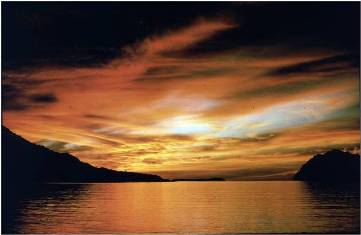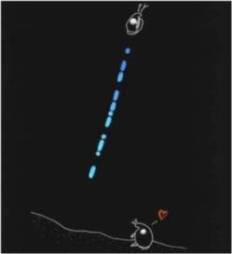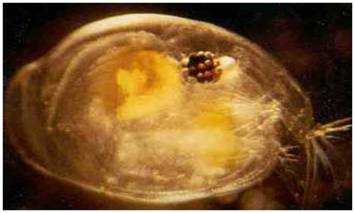- Photeros annecohenae is named for Dr.
Anne
C. Cohen, an expert in the field of ostracod
taxonomy and systematics.
Cohen has worked extensively with Photeros
annecohenae as well as many other species of
ostracod.
Dr. Cohen played a part in obtaining much of the
research used to create this website.
-
 Ostracod bioluminescent mating displays are only found in the
Caribbean Sea (Cohen and Morin 2010).
Ostracod bioluminescent mating displays are only found in the
Caribbean Sea (Cohen and Morin 2010). - The origin of the compound eye in Photeros annecohenae is independent from that in other arthropods (Gerrish and Morin 2008). This demonstrates convergent evolution.
- More is known about the system producing luminescence in bioluminescent ostracods than that of any other organisms (including bacteria and fireflies) (James G. Morin 2011).
- Courtship displays are one of the most complex luminescent signals known (Cohen and Morin 1990).
- Ostracods have a more complete fossil record than any other crustacean (Introduction to the Ostracoda 2002).
- Some species of ostracods have sperm five times the length of
their body!
Ostracods are also known for their large copulatory organs; male copulatory organs can reach up to 75% of the body’s volume (Gerrish Personal Communication)!
- The two lateral compound eyes are larger in males than
females; these eyes can cover move than 15% of the male’s body
(Morin 1986)!
- Male ostracods swim so rapidly during their mating displays
that they cover the human equivalent of one and a half football fields
per second (James G. Morin 2011)!
- Asian explorers of the past dried ostracods and
used them as dressings for their salads (Gerrish
Personal Communication). Mmm...Tasty!
As if Photeros annecohenae isn't interesting enough, here are some fun facts about the organism!

I chose Photeros annecohenae
for this project because I have heard a lot about it
from Dr. Gretchen Gerrish (my BIO 105 professor and BIO 203 lab
instructor), who has researched the organism extensively, and find the males’
 bioluminescent mating displays
fascinating. I also plan to work with this organism more closely
in Dr. Gerrish’s research lab in the future so figured the
webpage would be a great way to learn more about it! I believe
everyone should appreciate the complexity of this organism. Size
is definitely not an indicator of complexity, and Photeros
annecohenae is a strong example of that, especially with its characteristic
bioluminescence and how it uses this to adapt to life. Also, I think that anyone can
appreciate the beauty, complexity and diversity of this species'
luminescent displays. I am sure that most people I know do not know that
there are organisms out there that attract mates in such an
amazing way!
bioluminescent mating displays
fascinating. I also plan to work with this organism more closely
in Dr. Gerrish’s research lab in the future so figured the
webpage would be a great way to learn more about it! I believe
everyone should appreciate the complexity of this organism. Size
is definitely not an indicator of complexity, and Photeros
annecohenae is a strong example of that, especially with its characteristic
bioluminescence and how it uses this to adapt to life. Also, I think that anyone can
appreciate the beauty, complexity and diversity of this species'
luminescent displays. I am sure that most people I know do not know that
there are organisms out there that attract mates in such an
amazing way!

Now that you have completed your journey through the life of Photeros
annecohenae, view the References
page to check out the sources I used to create this site. Research them, and you
will learn even more
about the organism!
Home
